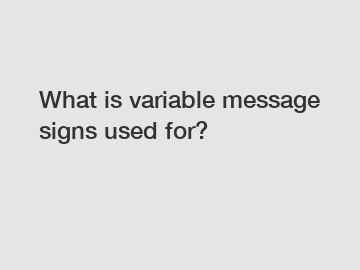What is variable message signs used for?
Variable Message Signs, commonly known as VMS, have become an integral part of our modern transportation systems. These innovative electronic displays are capable of conveying real-time information, rapidly changing messages, and important updates to motorists and pedestrians alike. In this article, we will delve into the various applications of VMS and their pivotal role in enhancing road safety, traffic management, and overall transportation efficiency.
1. Enhancing Road Safety:
Variable Message Signs have revolutionized the way we communicate road safety information. From alerting drivers about hazardous weather conditions or road closures to providing real-time updates about accidents and alternate routes, VMS plays a crucial role in minimizing accidents and ensuring the well-being of motorists. These signs can be strategically placed at critical locations such as highways, dangerous intersections, or construction zones to alert drivers and encourage cautious behavior.

2. Traffic Management and Congestion Control:
In congested urban areas, traffic management becomes a paramount concern. Variable Message Signs offer a dynamic solution to this issue by providing real-time traffic updates and suggesting alternate routes. They can display information about traffic volumes, estimated travel times, or even direct traffic flow through lane-specific instructions. This efficient management reduces traffic congestion, enhances overall transportation efficiency, and saves valuable time for commuters.
3. Emergency Management:
During emergency situations, swift and clear communication is vital. Variable Message Signs act as crucial tools in emergency management by instantly disseminating critical information to the public. Whether it's an evacuation notice during a natural disaster or a terrorist threat, VMS promptly conveys important instructions to ensure public safety. They also assist emergency services by guiding them to appropriate routes or clearing roads for faster response times.
4. Promoting Public Transit and Carpooling:
Encouraging sustainable transportation options like public transit and carpooling is crucial for reducing traffic congestion and minimizing environmental impact. Variable Message Signs play a significant role in promoting these alternatives by providing real-time data about public transportation schedules, routes, and availability. By showcasing incentives such as dedicated lanes or preferred parking for carpoolers, VMS incentivize these eco-friendly choices and contribute to a greener future.
5. Parking Guidance and Management:
Finding parking in crowded urban areas can be a daunting task, leading to frustration and unnecessary traffic congestion. Variable Message Signs offer a convenient solution by providing real-time parking guidance. These signs can display the number of available parking spaces in specific areas or parking garages, helping drivers make informed choices and reducing the time spent searching for a spot. This improved parking management also boosts the local economy by facilitating faster turnover and increased foot traffic.
6. Construction Zones:
Construction zones are notorious for causing disruptions and delays. Variable Message Signs help minimize inconvenience by providing updates on detours, lane closures, and estimated delays. These signs can guide motorists safely through construction zones, alerting them in advance about changing traffic patterns or hazards. By keeping drivers informed and reducing confusion, VMS significantly contribute to the efficiency of construction projects and the safety of workers and commuters.
Conclusion:
Variable Message Signs have rapidly evolved into multifunctional tools that improve road safety, traffic management, and transportation efficiency. Their ability to relay real-time information, dynamically adapt messages, and guide drivers allows for enhanced decision-making and smooth traffic flow. From emergency management to encouraging sustainable transportation options, VMS continues to revolutionize our modern transportation systems. As technology advances further, we can only expect these electronic displays to become even more efficient, creative, and impactful in shaping our daily commuting experiences.
For more information, please visit vms traffic, led yellow flash light, VMS Control Software.
262
0
0

Comments
All Comments (0)